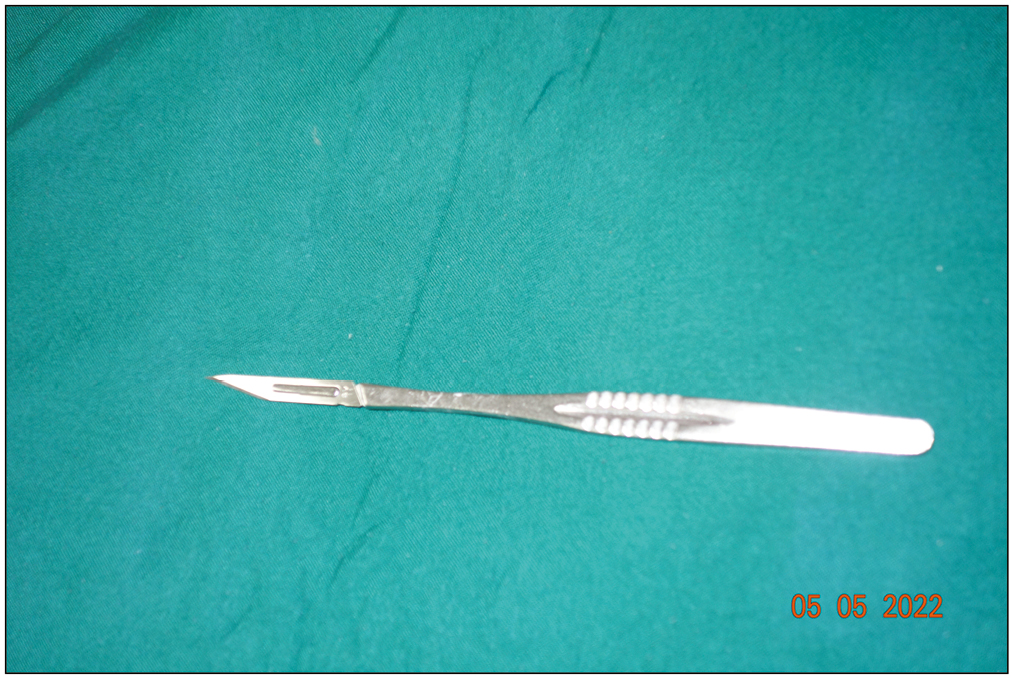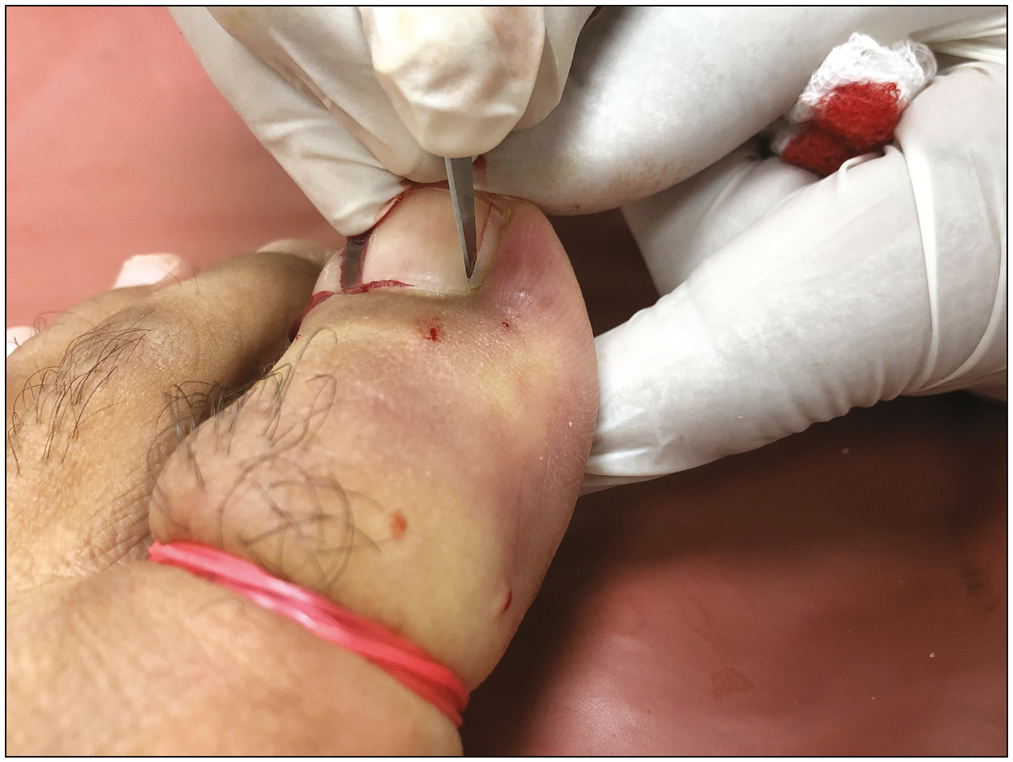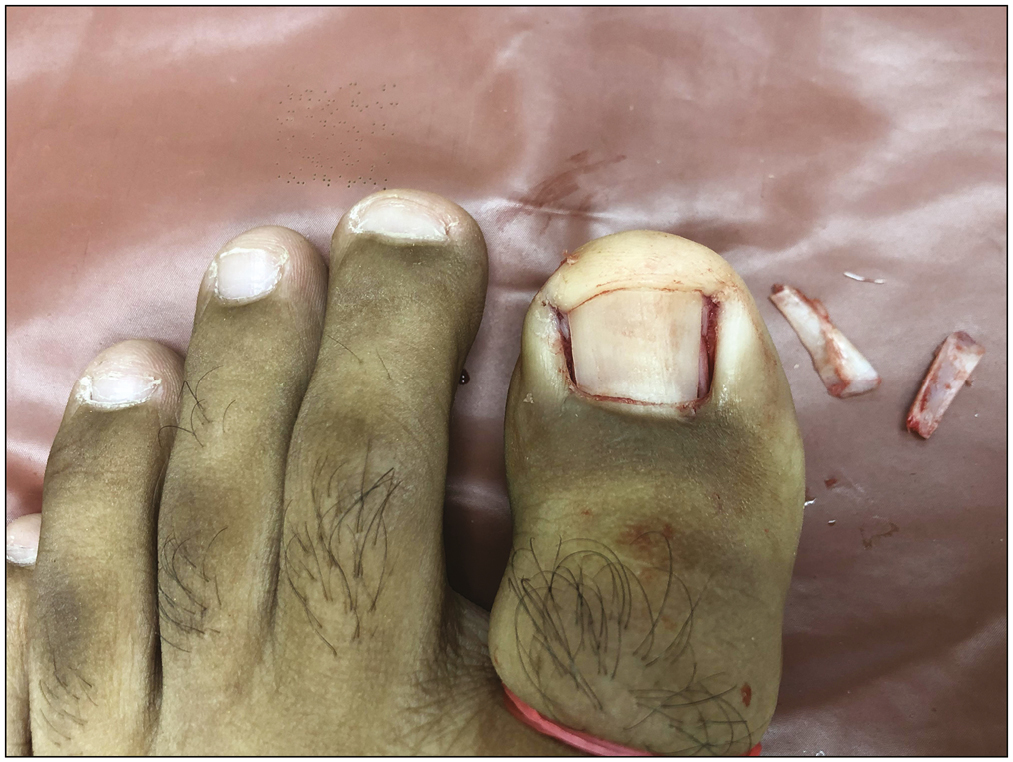Translate this page into:
A New Perspective on Partial Nail Avulsion: Surgical Pearl
Address for correspondence: Dr. Ratnakar K. Shukla, Department of Dermatology, All India Institute of Medical Sciences (AIIMS), Gorakhpur, Uttar Pradesh, India. E-mail: ratnakarshukla88@gmail.com
This article was originally published by Wolters Kluwer - Medknow and was migrated to Scientific Scholar after the change of Publisher.
Abstract
Abstract
Ingrown nail or onychocryptosis is a common and prevalent condition associated with pain and discomfort resulting from recurrent inflammation. It is further categorized into 3 grades on the basis of severity as per classification by Heifetz and Mogensen, grade 1 can be easily managed with medical treatment; whereas grades 2 and 3 often requires surgical treatment; the most common surgical technique employed for ingrown nail is the simple nail avulsion by using a nail clipper. we have observed that due to the force of the nail clipper small amount of detachment in between nail plate and nail bed in addition to longer downtime post-procedure, so we proposed a new surgical modification of nail avulsion by using 11 no. surgical blade instead of nail clippers leading to very less trauma to nail bed and fine post-procedure outcomes.
Keywords
Ingrown nail
nail avulsion
nail clipper
onychocryptosis
INTRODUCTION
Ingrown nail or onychocryptosis or unguis incarnatus is a very common and prevalent problem in which the nail plate grows into the periungual skin and causes recurrent inflammation and infection if left untreated.[1] It can cause considerable pain, discomfort, and disability. An ingrown toenail can involve any age ranging from childhood to old age, but most commonly it involves adolescent and young adults. The cardinal signs are curved nail plate, shovel-shaped toe and proud skin, and is usually aggravate by incorrect nail cutting. The great toe nail is the most frequent location.[2] The most frequent classification quoted in the literature is that first proposed by Heifetz (1937)[3] and subsequently used by Mogensen (1971).[4]
Grade 1: Pain, erythema, and slight swelling of the nail sulcus.
Grade 2: As above, accompanied by infection and suppuration and oozing
Grade 3: As above with the formation of granulation tissue (sometimes referred to as hyper-granulation tissue.
Grade 2 and grade 3 under classification by Heifetz and Mogensen requires definitive surgical intervention to relive the pain suffering produced by ingrown nail.[34]
The theory of the simple nail avulsion has long been established, but long downtime, significant pain, and swelling post-procedure have forced us to dig deeper into the surgical technique used for avulsion of nails.
PROBLEMS
In recent years, we have found that the nail clipper or scissors used during the procedure may lead into longer downtime post-procedure. It was observed that many a times despite using the finest nail clipper, some amount of force is required to clip the elevated nail plate, which can result into the forceful detachment of the small part of the adjacent nail plate from nail bed. This can give rise to traumatic event, which unfortunately can cause postoperative pain and swelling, thus resulting into long recovery time. Moreover, it can also result in some extra amount of normal avoidable nail plate clipping.
SOLUTION PROPOSED
Here, we proposed an easy and inexpensive way to cut nail plate and also providing precise results along the normal nail margin with the aid of 11 No. sharp cutting surgical blade instead of nail clipper [Figure 1], which is associated with very less trauma on adjacent tissue and fine post-procedure outcome

- Bald Parker handle with 11 No. sharp cutting surgical blade
PROCEDURE DETAILS- (VIDEO-1)

The required margins of the ingrown nail plate are first marked using surgical blade, keeping in mind to avoid nail bed injury. The knife is gradually moved from distal end of the nail plate with controlled pressure toward the proximal end [Figure 2] to reach nail matrix; resistance is felt during the horizontal movement of the blade. With controlled pressure the blade is moved toward the proximal nail fold and just before entering the proximal nail fold the tip of the blade is slightly angulated at 25°–30° angle to reach the lateral matrix horn. Loss of resistance during this movement marks the endpoint of nail matrix. The cut is made in a single stroke to avoid ragged nail plate phenomenon, which can result into poor post-procedural outcomes. After carefully cutting the margins of the desired plate, it is elevated from the nail bed using the nail splitter [Figure 3]. This simple change in the predetermined surgical procedure can lead into less recovery time, less trauma to the nail bed, and lesser post-surgical pain and swelling. We also found that as pathological nail plate itself acts as a good landmark, an accurate excision can be carried out without removal of the extra plate margins. Moreover, sterilized blades are cheaper and disposable, which eliminates the requirement of proper sterilization of the nail clipper.

- Cutting of nail plate with surgical blade applying controlled pressure toward nail matrix

- Nail plate after partial nail avulsion
CONCLUSION
To conclude, we propose using a sterile surgical blade over nail clipper in partial nail avulsion to improve the surgical outcome by decreasing the intensity of pain and swelling and reducing the amount of downtime from few weeks to 7 days for better patient compliance.
Declaration of patient consent
The authors certify that they have obtained all appropriate patient consent forms. In the form, the patient has given his consent for his images and other clinical information to be reported in the journal. The patient understand that name and initials will not be published and due efforts will be made to conceal identity, but anonymity cannot be guaranteed.
Financial support and sponsorship
Not applicable.
Conflicts of interest
There are no conflicts of interest.
REFERENCES
- Ingrowing toenail. Follow-up on 64 patients treated by labiomatricectomy. Acta Orthop Scand. 1971;42:94-101.
- [Google Scholar]






